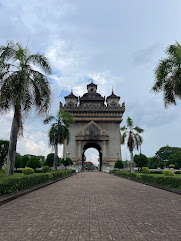Laos, Lao, & Laotians
We only had a few locations in Laos, concentrated in the North, in order for us to make our June 27 deadline to fly out of South East Asia. We pretty much stayed on the "banana pancake" route (the circuit many backpackers take through SE Asia) and hit the locations of Luang Prabang, Nong Khiaw, Vang Vieng, and Vientiane. It would have been great to have gotten off the typical tourist route to see central and south Laos, but there just wasn't the time.
Laos was the 8th country of the trip so far and completed our list of countries that we would visit in South East Asia. Overall, I found it to be an interesting mix of several of the neighboring countries we had already visited, with hints of Thai, Khmer, and Vietnamese food and culture blended together. It also was very educational for me, as I learned about the US's own sordid history with the country. It was difficult really getting a feel for the true Laos, as we were just moving through it too quickly to really see much beyond the surface tourist stuff.
Our first stop in Laos was Luang Prabang, a highlight of which being the night markets, our favorite way to dine, and my reunification with my beloved coconut pancakes that I had missed since Thailand. We did a sunset cruise in the river, but also spent some pretty low-key time around town while Johnny recovered from a sinus infection of some sort and we tried to avoid the worst of the intense heat. We did brave the +118 F temps one day to take a motorbike out to Kuang Si Waterfall, thankfully which had lots of swimming to keep us cool, although I'm not sure I've ever felt heat like that on our motorbike trip back to town. We also managed the stair climb to the top of Phousi Hill to watch the sunset.
From there, we were off the Nong Khiaw. This is probably one of the smallest and quietest towns we've hit on the whole trip so far. We were amazed at the heaping bowls of curry and rice noodles we were able to order for what would be less than $2.50 USD. The heat kept us in our hotel for parts of the day, luckily we had one of our best views, situated right on the river. We waited until evening to hike to the town's viewpoint, an hour of a straight-up, non-stop climb to Pha Daeng Peak. Despite the later time, I still managed to sweat out at least 2 bucket-fulls. It literally looked like someone had dunked us underwater, every inch was drenched. Fortunately, we had slightly cooler temps the day we signed up for an all-day tour of the local villages, which also included a cave, waterfall, and evening kayak on the river. Johnny was looking forward to seeing some of the even more remote villages, while I enjoyed chugging along the river in our local style boat. We also met some fun folks that we would see again later in our Laos journey.
Getting to our next stop would require us to pass back through Luang Prabang to board a very unexpected high-speed train that runs services through Laos to China. It is pretty trippy to drive past small roadside food stands and random buffalos in the road only to roll up to this new, sparkly airport-type terminal that is the station for the China-Laos Railway. From there, it was a short train ride to Vang Vieng.
Vang Vieng has previously been known as the party stop, famous for its tipsy tubing on the Nam Song River, where the bars that line the riverbanks throw lines out to you as you float by in order to partake in beverages. We only saw a small shadow of some of the levels we had heard of, in part because they've really cracked down on it in recent years after a series of deaths directly related to drunken debauchery, and in part because we were there during low season. (Most people opt to avoid traveling there during the heat that we were enduring every day). We did not tube down the river, but rather took some kayaks through the same route just to check it out with a local guide and got to paddle past the few tubers in their revelry.We did take a motorbike for a couple of the days we were there to hike to the Pha Ngern Viewpoint and visit a couple of the blue lagoons. Of the possible 9 (?) Blue Lagoons, we visited Lagoon #1 and Lagoon #3. Very different in feel, Lagoon #1 was more of a local spot and despite being busy, we were some of the few Westerners there. Johnny loved it for its high jump platform into the pool. Lagoon #3 on the other hand didn't appear to have any locals and was equipped with a zipline and rope swing. There is also a nearby cave you can explore, where I was reminded of a VERY valuable lesson in that you should probably not wander into unknown caves alone. Obviously, I made it out, but there may or may not have been some mild panic when me and a random German guy couldn't manage to find the way we came. 10 minutes lost in a cave feels like an eternity.













Comments
Post a Comment